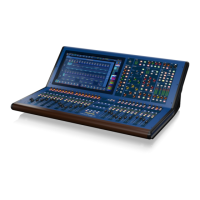162 HD96-24-CC-TP User Manual
DSR De-esser
The de-esser is designed to reduce sibilance in human voices, such as excessive presence of S sounds.
Due to the special sibilant detection algorithm, the de-esser is completely input level independent. This means that the reduction of sibilants will not change if the
input level is changed. For example, changing the microphone amplier gain does not aect the detector.
Although the de-esser is primarily designed to be applied on human voices, it can also be used creatively on other instruments.
• • X-over Control Part of the detection algorithm is a matched lowpass/highpass crossover lter. The crossover frequency is adjusted by the crossover knob. When
a normal, non-sibilant, sound is present in the input the energy will be mostly focused in the lower section on the frequency spectrum. On the other hand, when a
sibilant sound is present most of the energy will be present in the higher section of the frequency spectrum. Therefore, the crossover knob is useful for tuning the
detector so that the de-essing mechanism is only triggered by high-frequency energy content, as it would occur with an S sound.
The optimal crossover frequency value is indicated by the high pass lter being lit blue only when a sibilant sound is present.
• • De-Essing Control When a sibilant is successfully detected the amount of reduction can be adjusted by using the de-essing knob. At minimum position,
the reduction is 0 and equivalent to bypass, i.e. the audio is not aected. As the user turns the knob clockwise, the number of sibilants will be reduced.
• • Listen When the Listen button is pressed the signal from the high pass lter is routed directly to the output.
Item Control Function
1 Gain Reduction meters 28 LEDs, which show gain reduction metering.
2 Out meters 28 LEDs, which show output metering.
3 DE-ESSING slider
When a sibilant sound is successfully detected the amount of reduction can be adjusted by using
the de-essing slider. At minimum position, the reduction is 0 and equivalent to bypass. Moving the
slider clockwise will reduce the amount of sibilance.
4 X-Over slider
Part of the detection algorithm is a matched lowpass/highpass crossover lter. The crossover
frequency is adjusted by the crossover slider. When a normal, non-sibilant, sound is present in the
input the energy will be mostly focused in the lower section on the frequency spectrum. When a
sibilant sound is present most of the energy will be present in the higher section of the frequency
spectrum. Therefore, the crossover knob is useful for tuning the detector so that the de-essing
mechanism is only triggered by high-frequency energy content, as it would occur with an s sound.
5 Bypass button When pressed the input signal is unaected.
6 Listen button
When the Listen button is pressed the signal from the high pass lter is routed directly to the output
of the de-esser, enabling ne-tuning of the crossover. Note that this happens in place, i.e. the main
output is ltered, therefore the user should be very careful when using it. The enable listen button
must be active to use this function.

